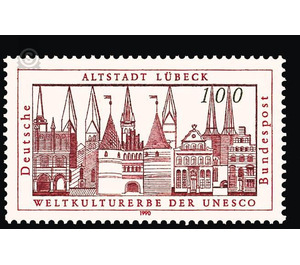UNESCO world heritage - Germany / Federal Republic of Germany 1990 - 100 Pfennig
Theme: Architecture
| Country | Germany / Federal Republic of Germany |
| Issue Date | 1990 |
| Face Value | 100.00 |
| Color | brown |
| Perforation | K 14 |
| Printing Type | combined intaglio and offset printing |
| Stamp Type | Postage stamp |
| Item Type | Stamp |
| Chronological Issue Number | 1320 |
| Chronological Chapter | GER-BRD |
| SID | 472101 |
| In 51 Wishlists | |
With the medieval center of the Hanseatic city of Lübeck, in 1987, for the first time in northern Europe, an entire old town was recognized by the UNESCO World Heritage Commission as part of the World Cultural Heritage. Decisive factors here were the striking city skyline, the specific urban structure with its characteristic street and walkway network, as well as the largely closed pre-industrial building fabric. Thus, the Hanseatic city of Lübeck still has an exemplary character for the Hanseatic city family in the Baltic Sea region and is therefore extremely productive for archaeological research into medieval urbanism and an example of high-class urban planning in order to give due recognition to the international significance of the Hanseatic League , The founding of Lübeck as the first German city on the Baltic Sea in 1143 was the continuous continuation of an already existing for several centuries Slavic settlement structure with castle settlement on the Lübeck Altstadthügel. But it was not until the second founding in 1159 under Henry the Lion after the great city fire of 1157 that the basic principles that continue to this day are laid down. Lübeck developed a legal, urban and architectural structure of such far-reaching distinctiveness that it has been described as a "prototype" of the medieval city. The urban fabric of a harbor and market settlement in the city's early stages is continuously blossoming into a fully developed city. This development was crowned by the recognition as "Civitas Imperii", as a free imperial city by the Hohenstaufen Emperor Frederick II in 1226, a legal status that Lübeck was to retain until 1937. From 1230 to 1535, Lübeck forms figuratively the political head of the Hanseatic League of Cities, an association of merchant-trading cities in Europe. Lübeck became the trading center of the north, which knew how to handle the entire north-south trade in goods. It managed to secure the trade monopoly for the Baltic and North Seas, while at the same time Venice and Genoa dominated the Mediterranean. The road system, which is still binding and only partially regular, and which is finally fixed by the Lübische building law, consists of a core, still pre-German, long-distance trade route. The town plan of Lübeck is characterized by two parallel to each other on the crest of the old town island running main roads, from the north-south axis branch off a variety of transverse ridge roads. The Rippenstraßen system is divided by connecting side streets into building blocks, to whose center the so-called "aisles" provide access. The urban center of the city is the ensemble of Markt with the town hall and the landmark of the brick Gothic, the twin-towered St. Mary's Church, situated on the highest point of the old town hill. Urban counterweights are created in the south by the cathedral district, in the north by the Koberg with the Jakobikirche and in the east of the old town by the district of the small craftsmen with the Aegidienkirche. In the middle of the 14th century Lübeck was at the height of its greatness and political power. All Lübeck city churches were completed in the highly Gothic design. To this day, Lübeck's silhouette is determined by the seven towers of its old churches situated on the ridge, which protrude from the surging sea of houses and form the landmarks for the individual neighborhoods. Lübeck remained so until the Second World War, whose bombs hit sensitive wounds in the hitherto homogeneous city body, a characteristic city monument with characteristic historical structural features. Lübeck, as a trans-regionally significant city, was the hub in the trade network between Western, Northern and Eastern Europe until 1800. Accordingly, one finds architectural forms of all epochs from late Romanesque to Biedermeier and in Lübeck houses. No "architectural museum", but a living urban organism, whose core structure remained the structures built in the High Gothic. Here, the archaeological underground formed a floor archive, whose findings and finds document the overwhelming importance of the Hanseatic city not only for architectural history, but also for economic, social and cultural history. (Text: The Mayor of the Hanseatic City of Lübeck, Office for the Preservation of Monuments)


